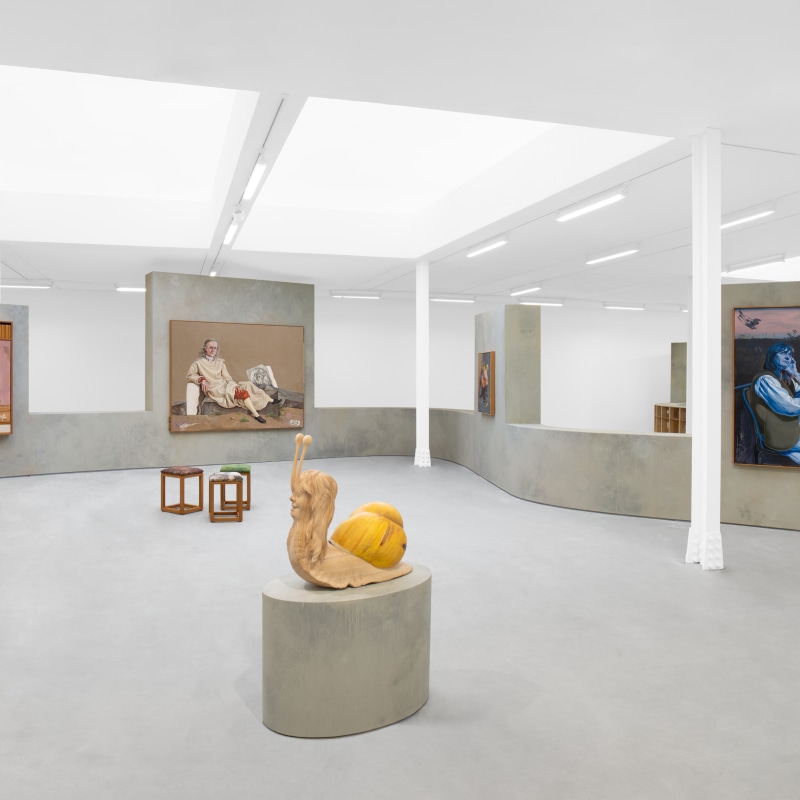In her third exhibition at Sadie Coles HQ, Kati Heck presents a group of new paintings and sculptures that take their cue from established tropes of art history. From still life to landscape and self-portraiture, the inherent symbolism contained in each work is upended and recoded with a surrealist impulse that speaks to ideas of the unconsciousness, desire and escape. Each painting is mounted on a self-supporting structure that carves a path through the gallery, appearing like a low wall, allowing views through and beyond the installation.
A linear route from beginning to end is suggested by this intervention, and yet, the snaking architecture frames a series of returns and repeated views of the work. The corporeality of this walk-through space produces an echo in time that speaks to the existential impulse of Heck's inquiry. The work reaches back through the history of painting to unearth universal concerns of humanity. It pulls them into the present and demands engagement in a contemporary context. Historical paintings are reworked and adapted by Heck to better understand the original questions they posed, while also seeking to ask another: does the encounter with art continue to mobilise humanity toward common ground? The artist's self-image and presence in the work seems to offer an extended hand to guide the viewer through the exhibition, leading us physically along the path to unearth persistent questions.
In one such painting, we see a reworking of the winged figure of Nemesis, as depicted by Albrecht Dürer in his engraving of 1502. In the original work, the spirit of divine retribution stands on a sphere, holding a bridle as a symbol of the restraint of human folly, and a metal urn that forewarns of the direst consequences of all. In Heck's version, the wings are a billowing garment, the urn a mirror that reflects her younger self. Nemesis no longer appears as a distant myth of moralising authority, but as an internalised struggle that exists in all of us. In another work, we see Adam and Eve in the garden of Eden. Where most historical depictions centre on the disobedient act that secured all of humanities' future suffering, in Heck's reimagining there is no apple in their hands, and yet the scene is pregnant with anticipation of their failure. Dozens of animal eyes can be seen lurking in the background, their collective gaze trained on us. The elusive apples from this scene instead appear on the floor in sculptural form, rendered in cast bronze and carved wood. Temptation is proffered as an obstacle to contend with, or perhaps as a provision for the journey ahead.
This doubling continues through the exhibition as animals escape the paintings into the space as sculpture. The artist is present at every turn, either inside the paintings or in works such as Selbst als Schnecke (2024) that populate the spaces delineated by the meandering wall. As such, the viewer is cast in a set of relations that rebound infinitely. Like a bird of passage our minds navigate time without a linear trajectory: symbols reappear, migration is ever possible, and history assumes a cyclical nature. Moving through the exhibition, we experience the echo that Kati Heck has set in motion. An echo, as a call and its response, not only a spatial signature but a temporal one, too. She calls out to the questions of the past, and their return reverberates in the present, ricocheting through time and space with universal urgency.
Kati Heck (b. 1979, Düsseldorf) lives and works in Pulle, Belgium. She has exhibited internationally, with recent solo shows including Hall Art Foundation, Kunstmuseum Schloss, Derneburg (2022); Bonnie Bonne Bon, Sadie Coles HQ, London (2021); Hauruck d’Orange, GEM museum voor actuele kunst, The Hague (2020); Heimlich Manoeuvre, Sadie Coles HQ, London (2017); Holy Hauruck, M HKA, Antwerp (2016); KOPF = KOPFNUSS, CAC Malaga (2013); Solanum Tuberosum. Tauben sprechen kein Deutsch, Atelierschiff der Stadt, Frankfurt (2010); and Bonzenspeck und Prollgehabe, Museum Het Domein, Sittard (2008). Recent group exhibitions include DIX AND THE PRESENT, Deichtorhallen Hamburg (2023); Let’s Play Museum, M HKA Museum of Contemporary Art, Antwerp (2023); Risquons-Tout, WIELS, Brussels (2020); QUADRO, Deichtorhallen Hamburg (2020); Salon de Peinture, M HKA, Museum of Contemporary Art Antwerp (2019); 50 years Middelheim Promotors, Middelheim museum, Antwerp (2015) and Happy Birthday Dear Academie, MAS, Antwerp (2013). A monograph was published on her work in 2016 by Hatje Cantz.
